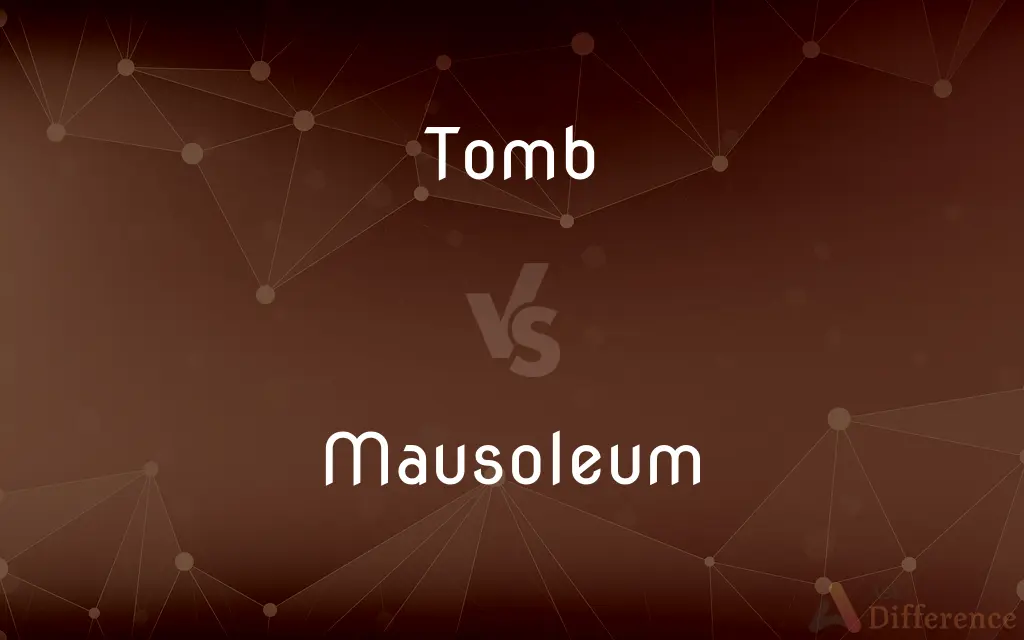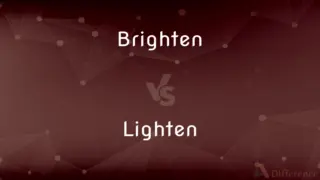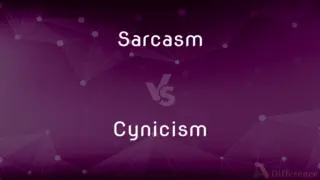Tomb vs. Mausoleum — What's the Difference?
By Tayyaba Rehman — Updated on November 5, 2023
A tomb is a structure for human remains, while a mausoleum is a larger, more elaborate building specifically designed for entombment.

Difference Between Tomb and Mausoleum
Table of Contents
ADVERTISEMENT
Key Differences
A tomb is a repository for the remains of the dead, typically found underground or within a mound of earth. Mausoleums are elaborate tombs, often above ground, and are designed to house multiple individuals, usually of the same family or significant social standing. Both serve as final resting places, but mausoleums are generally more monumental.
The term "tomb" encompasses a broad range of burial structures, from simple grave markers to grand monuments. A mausoleum is a specific type of tomb, characterized by its sizable, house-like construction. Both tombs and mausoleums are culturally significant, often reflecting the societal status of the individuals within.
Tombs can be solitary and unadorned, intended for a single individual. In contrast, mausoleums are communal and architecturally significant, built to accommodate several entombments over generations. While all mausoleums are tombs, not all tombs are mausoleums.
The design of a tomb is usually simpler and less ornate than that of a mausoleum. Mausoleums stand out for their architectural beauty, often embellished with art and surrounded by landscaped gardens. Both types of structures serve as historical landmarks and are crafted to endure through time.
In practice, the choice between a tomb and a mausoleum may be influenced by personal, religious, or cultural preferences. Mausoleums, with their grandeur, may be chosen by those who wish for a more pronounced memorial, while tombs provide a wide range of burial options, from modest to magnificent.
ADVERTISEMENT
Comparison Chart
Definition
A chamber for the dead, often underground.
An elaborate, free-standing building for the dead.
Size
Can range from small to large.
Typically large and spacious.
Capacity
Generally for an individual or a family.
Designed to house multiple individuals or families.
Construction
Simpler, less ornate.
Architecturally significant, often ornate.
Location
Underground, earth mounds, or within cliffs.
Above ground, often in cemeteries or private land.
Compare with Definitions
Tomb
A tomb is a small-scale burial site, often for a single person.
The ancient tomb was discovered hidden beneath the vines.
Mausoleum
A mausoleum is an ornate structure for entombment above ground.
The family built a mausoleum that overlooked the city.
Tomb
Tombs can be adorned with epitaphs and symbols reflecting the deceased's life.
Visitors left flowers at the poet's tomb.
Mausoleum
Mausoleums are prominent edifices often reflecting wealth or social status.
The grand mausoleum was the centerpiece of the old cemetery.
Tomb
A tomb is a historical landmark for individuals of significance or common citizens.
The war hero's tomb became a site of pilgrimage.
Mausoleum
Mausoleums are constructed with architectural significance and durability.
The mausoleum featured stained glass and intricate carvings.
Tomb
Tombs are often made from stone or marble to withstand time.
The tomb's marble façade had withstood centuries of weathering.
Mausoleum
Mausoleums often have walk-in chambers and vestibules for visitors.
The mausoleum's interior was lined with portraits of the entombed.
Tomb
A tomb (Greek: τύμβος tumbos) is a repository for the remains of the dead. It is generally any structurally enclosed interment space or burial chamber, of varying sizes.
Mausoleum
A mausoleum is an external free-standing building constructed as a monument enclosing the interment space or burial chamber of a deceased person or people. A mausoleum without the person's remains is called a cenotaph.
Tomb
A large vault, typically an underground one, for burying the dead.
Mausoleum
A large stately tomb or a building housing such a tomb or several tombs.
Tomb
A grave or other place of burial.
Mausoleum
A gloomy, usually large room or building.
Tomb
A vault or chamber for burial of the dead.
Mausoleum
A large stately tomb or a building housing such a tomb or several tombs.
Tomb
A monument commemorating the dead.
Mausoleum
(by extension) A gloomy, usually large room or building.
Tomb
A small building (or "vault") for the remains of the dead, with walls, a roof, and (if it is to be used for more than one corpse) a door. It may be partly or wholly in the ground (except for its entrance) in a cemetery, or it may be inside a church proper or in its crypt. Single tombs may be permanently sealed; those for families (or other groups) have doors for access whenever needed.
Mausoleum
A magnificent tomb, or stately sepulchral monument.
Tomb
A pit in which the dead body of a human being is deposited; a grave.
Mausoleum
A large burial chamber, usually above ground
Tomb
One who keeps secrets.
Mausoleum
A mausoleum can serve as a family burial chamber for generations.
They visited the ancestral mausoleum to pay respects.
Tomb
(transitive) To bury.
Tomb
A pit in which the dead body of a human being is deposited; a grave; a sepulcher.
As one dead in the bottom of a tomb.
Tomb
A house or vault, formed wholly or partly in the earth, with walls and a roof, for the reception of the dead.
Tomb
A monument erected to inclose the body and preserve the name and memory of the dead.
Hang her an epitaph upon her tomb.
Tomb
To place in a tomb; to bury; to inter; to entomb.
I tombed my brother that I might be blessed.
Tomb
A place for the burial of a corpse (especially beneath the ground and marked by a tombstone);
He put flowers on his mother's grave
Tomb
A tomb is a vault for the deceased, marking their place of rest.
Inscriptions on the tomb revealed the name of the once-forgotten king.
Common Curiosities
How is a mausoleum different from a tomb?
A mausoleum is a large, stately building specifically designed for entombing the dead, usually above ground.
What is the purpose of a mausoleum?
The purpose of a mausoleum is to provide a dignified, permanent resting place for the dead.
What defines a tomb?
A tomb is a structure or chamber for the burial of the dead, often underground.
Can anyone be buried in a mausoleum?
While anyone can be interred in a mausoleum, they are often reserved for individuals or families with the means to construct them.
Is a crypt the same as a tomb?
A crypt is a type of tomb, typically an underground chamber beneath a church or within a mausoleum.
Why would someone choose a tomb over burial in the ground?
Personal, religious, or cultural reasons, as well as considerations for preservation, may influence the choice of a tomb.
Do mausoleums prevent decomposition?
Mausoleums do not prevent decomposition but may slow it due to their construction and environment.
Are all tombs made of stone?
Many tombs are stone, but materials vary widely, including wood, metal, and more.
Can tombs be part of a family estate?
Yes, private tombs can be situated on family land or estates.
Are tombs environmentally friendly?
The environmental impact of tombs varies based on materials and construction methods.
Are there famous mausoleums I can visit?
Yes, famous mausoleums like the Taj Mahal in India are open to the public.
Do mausoleums have a religious significance?
Mausoleums can have religious significance but are also used secularly, depending on the culture and preferences of those who build them.
Can a mausoleum hold cremated remains?
Yes, mausoleums can house cremated remains in urns within niches.
Is it more expensive to be entombed in a mausoleum?
Generally, entombment in a mausoleum is more costly than traditional burial due to the construction and maintenance involved.
Do tombs and mausoleums have security concerns?
Both can be subject to security concerns, such as vandalism, and may be protected by various means.
Share Your Discovery

Previous Comparison
Brighten vs. Lighten
Next Comparison
Sarcasm vs. CynicismAuthor Spotlight
Written by
Tayyaba RehmanTayyaba Rehman is a distinguished writer, currently serving as a primary contributor to askdifference.com. As a researcher in semantics and etymology, Tayyaba's passion for the complexity of languages and their distinctions has found a perfect home on the platform. Tayyaba delves into the intricacies of language, distinguishing between commonly confused words and phrases, thereby providing clarity for readers worldwide.














































